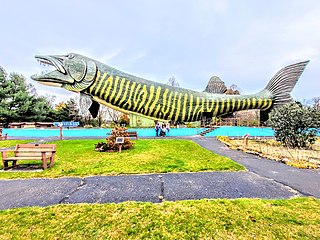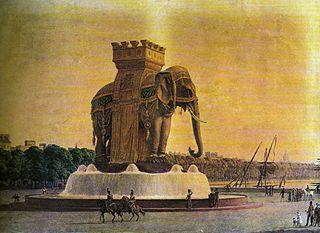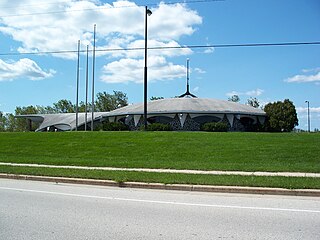
The muskellunge, often shortened to muskie,musky, ski, or lunge, is a species of large freshwater predatory fish native to North America. It is the largest member of the pike family, Esocidae.

Lutefisk is dried whitefish, usually cod, but sometimes ling or burbot, cured in lye. It is made from aged stockfish, or dried and salted cod. The fish takes a gelatinous texture after being rehydrated for days prior to eating.

Bena is a city in Cass County, Minnesota, United States. The population was 143 at the 2020 census. It is part of the Brainerd Micropolitan Statistical Area.

Lucy the Elephant is a six-story elephant-shaped example of novelty architecture, constructed of wood and clad in tin in 1882 by James V. Lafferty in Margate City, New Jersey, approximately five miles (8 km) south of Atlantic City. Originally named Elephant Bazaar, Lucy was built to promote real estate sales and attract tourists. Today, Lucy is the oldest surviving roadside tourist attraction in America.

Hayward is a city in Sawyer County, Wisconsin, United States, next to the Namekagon River. Its population was 2,533 at the 2020 census. It is the county seat of Sawyer County. The city is surrounded by the Town of Hayward. The City of Hayward was formally organized in 1883.

Googie architecture is a type of futurist architecture influenced by car culture, jets, the Atomic Age and the Space Age. It originated in Southern California from the Streamline Moderne architecture of the 1930s, and was popular in the United States from roughly 1945 to the early 1970s.

Lefse is a traditional soft Norwegian flatbread. It is made with riced potatoes, can include all purpose (wheat) flour, and includes butter, and milk, cream, or lard. It is cooked on a large, flat griddle. Special tools are used to prepare lefse, including a potato ricer, long wooden turning sticks and special rolling pins with deep grooves.

A roadside attraction is a feature along the side of a road meant to attract tourists. In general, these are places one might stop on the way to somewhere, rather than being a destination. They are frequently advertised with billboards. The modern tourist-oriented highway attraction originated as a U.S. and Canadian phenomenon in the 1940s to 1960s, and subsequently caught on in Australia.

A supper club is a traditional dining establishment that also functions as a social club. The term may describe different establishments depending on the region, but in general, supper clubs tend to present themselves as having a high-class image, even if the price is affordable to all. In the 2010s, a newer usage of the term supper club emerged, referring to underground restaurants.
Green Giant and Le Sueur are brands of frozen and canned vegetables owned by B&G Foods. The company's mascot is the Jolly Green Giant.

Novelty architecture, also called programmatic architecture or mimetic architecture, is a type of architecture in which buildings and other structures are given unusual shapes for purposes such as advertising or to copy other famous buildings without any intention of being authentic. Their size and novelty means that they often serve as landmarks. They are distinct from architectural follies, in that novelty architecture is essentially usable buildings in eccentric form whereas follies are non-usable, purely ornamental buildings also often in eccentric form.

The Gobbler was a motel, supper club, and roadside attraction in Johnson Creek, Wisconsin, United States. It was designed in the late 1960s by Fort Atkinson architect Helmut Ajango for local poultry processor Clarence Hartwig and opened in 1967. The menu featured turkey, prime rib and steak. It included a rotating circular bar that completed one revolution every 80 minutes. The Gobbler was at the intersection of Wisconsin Highway 26 and I-94, halfway between Milwaukee and Madison, Wisconsin. It closed in 1992. The original restaurant building reopened as the Gobbler Theater in late 2015.
Big Fish is a 2003 American film.

Wagon Wheel is a densely populated, planned neighborhood of Oxnard, California at the intersection of U.S. Route 101 and Oxnard Boulevard. The neighborhood was originally developed as an office, motel, and restaurant complex named Wagon Wheel Junction with a convenient roadside location near the historic community of El Rio. The site in Ventura County became a popular stop for travelers between Los Angeles and Santa Barbara, particularly during its heyday in the 1950s, 1960s and 1970s. The entire site was demolished in 2011 to begin the development of the community with 1,500 residential units. The Esplanade Shopping Center is directly across Oxnard Boulevard with The Collection at RiverPark shopping center located farther along Oxnard Boulevard on the other side of the 101 freeway.
Eric Dregni is an American author. He is an associate professor of English and Journalism at Concordia University in Saint Paul, Minnesota, where he teaches writing. He has written or cowritten travel memoirs and essays about Minnesota, Norway, and Italy, as well as guidebooks and books on popular culture in the American Midwest.

Mighty Og was a roadside attraction consisting of a 36-foot (11 m) high sculpture of a gorilla from the waist up. It originally graced a billboard promoting Rawhide City, a tourist attraction in Mandan, North Dakota.

The Nevis Tiger Muskie is a sculpture located at 114-122 Bunyan Trails Rd, Nevis, Minnesota.
Bug-O-Nay-Ge-Shig School is a K-12 tribal school in unincorporated Cass County, Minnesota, near Bena. It is affiliated with the Bureau of Indian Education (BIE). Located on the Leech Lake Indian Reservation, it serves the Leech Lake Band of Ojibwe. It is nicknamed the "Bug School".















